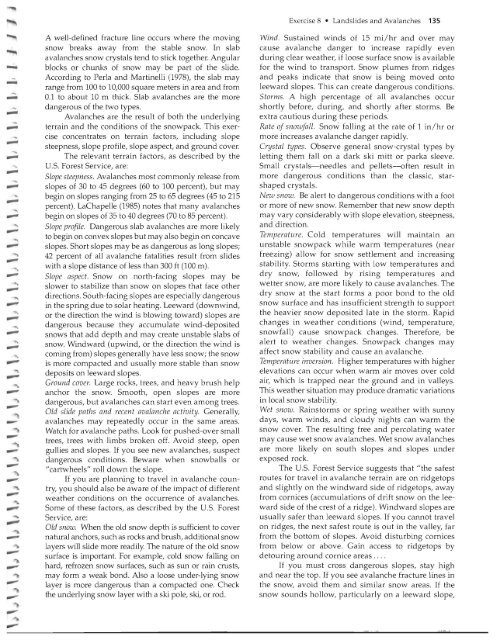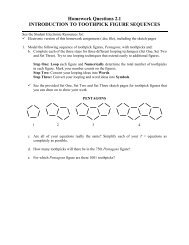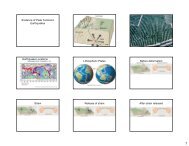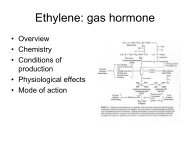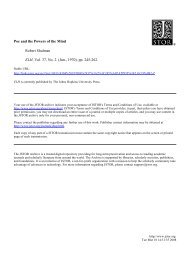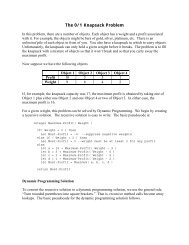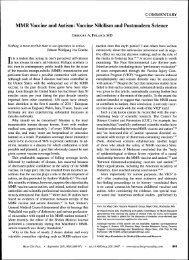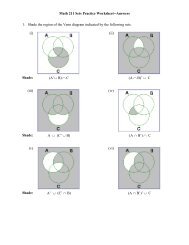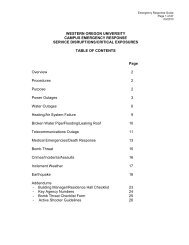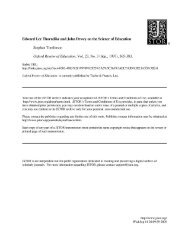Landslides and Avalanches
Landslides and Avalanches
Landslides and Avalanches
Create successful ePaper yourself
Turn your PDF publications into a flip-book with our unique Google optimized e-Paper software.
- According<br />
- dangerous<br />
- cise<br />
.....<br />
-- U.s.<br />
--<br />
--<br />
-- --.,...<br />
snow.<br />
-- deposits<br />
-<br />
- gullies<br />
- Watch<br />
- layers<br />
A well-defined fracture line occurs where the moving<br />
snow breaks away from the stable snow. In slab<br />
avalanches snow crystals tend to stick together. Angular<br />
blocks or chunks of snow may be part of the slide.<br />
to Perla <strong>and</strong> Martinelli (1978), the slab may<br />
range from 100 to 10,000 square meters in area <strong>and</strong> from<br />
0.1 to about 10 m thick. Slab avalanches are the more<br />
of the two types.<br />
<strong>Avalanches</strong> are the result of both the underlying<br />
terrain <strong>and</strong> the conditions of the snowpack. This exerconcentrates<br />
on terrain factors, including slope<br />
steepness, slope profile, slope aspect, <strong>and</strong> ground cover.<br />
The relevant terrain factors, as described by the<br />
Forest Service, are:<br />
Slope steepness. <strong>Avalanches</strong> most commonly release from<br />
slopes of 30 to 45 degrees (60 to 100 percent), but may<br />
begin on slopes ranging from 25 to 65 degrees (45 to 215<br />
percent). LaChapelle (1985) notes that many avalanches<br />
begin on slopes of 35 to 40 degrees (70 to 85 percent).<br />
Slope profile. Dangerous slab avalanches are more likely<br />
to begin on convex slopes but may also begin on concave<br />
slopes. Short slopes may be as dangerous as long slopes;<br />
42 percent of all avalanche fatalities result from slides<br />
with a slope distance of less than 300 ft (100 m).<br />
Slope aspect. Snow on north-facing slopes may be<br />
slower to stabilize than snow on slopes that face other<br />
directions. South-facing slopes are especially dangerous<br />
in the spring due to solar heating. Leeward (dowmvind,<br />
or the direction the wind is blowing toward) slopes are<br />
dangerous because they accumulate wind-deposited<br />
snows that add depth <strong>and</strong> may create unstable slabs of<br />
Windward (upwind, or the direction the wind is<br />
coming from) slopes generally have less snow; the snow<br />
is more compacted <strong>and</strong> usually more stable than snow<br />
on leeward slopes.<br />
Ground cover. Large rocks, trees, <strong>and</strong> heavy brush help<br />
anchor the snow. Smooth, open slopes are more<br />
dangerous, but avalanches can start even among trees.<br />
Old slide paths <strong>and</strong> recent avalanche activity. Generally,<br />
avalanches may repeatedly occur in the same areas.<br />
for avalanche paths. Look for pushed-over small<br />
trees, trees with limbs broken off. Avoid steep, open<br />
<strong>and</strong> slopes. If you see new avalanches, suspect<br />
dangerous conditions. Beware when snowballs or<br />
"cartwheels" roll down the slope.<br />
If you are planning to travel in avalanche country,<br />
you should also be aware of the impact of different<br />
weather conditions on the occurrence of avalanches.<br />
Some of these factors, as described by the U.s. Forest<br />
Service, are:<br />
Old snow. When the old snow depth is sufficient to cover<br />
natural anchors, such as rocks <strong>and</strong> brush, additional snow<br />
will slide more readily. The nature of the old snow<br />
surface is important. For example, cold snow falling on<br />
hard, refrozen snow surfaces, such as Slill or rain crusts,<br />
may form a weak bond. Also a loose under-lying snow<br />
layer is more dangerous than a compacted one. Check<br />
the underlying snow layer with a ski pole, ski, or rod.<br />
Exercise 8 • <strong>L<strong>and</strong>slides</strong> <strong>and</strong> <strong>Avalanches</strong> 135<br />
Wind. Sustained winds of 15 mi/hr <strong>and</strong> over may<br />
cause avalanche danger to increase rapidly even<br />
during clear weather, if loose surface snow is available<br />
for the wind to transport. Snow plumes from ridges<br />
<strong>and</strong> peaks indicate that snow is being moved onto<br />
leeward slopes. This can create dangerous conditions.<br />
Storms. A high percentage of all avalanches occur<br />
shortly before, during, <strong>and</strong> shortly after storms. Be<br />
extra cautious during these periods.<br />
Rate of snowfall. Snow falling at the rate of 1 in/hr or<br />
more increases avalanche danger rapidly.<br />
Crystal types. Observe general snow-crystal types by<br />
letting them fall on a dark ski mitt or parka sleeve.<br />
Small crystals-needles <strong>and</strong> pellets-often result in<br />
more dangerous conditions than the classic, starshaped<br />
crystals.<br />
New snow. Be alert to dangerous conditions with a foot<br />
or more of new snow. Remember tha t new snow depth<br />
may vary considerably with slope elevation, steepness,<br />
<strong>and</strong> direction.<br />
Temperature. Cold temperatures will maintain an<br />
unstable snowpack while warm temperatures (near<br />
freezing) allow for snow settlement <strong>and</strong> increasing<br />
stability. Storms starting with low temperatures <strong>and</strong><br />
dry snow, followed by rising temperatures <strong>and</strong><br />
wetter snow, are more likely to cause avalanches. The<br />
dry snow at the start forms a poor bond to the old<br />
snow surface <strong>and</strong> has insufficient strength to support<br />
the heavier snow deposited late in the storm. Rapid<br />
changes in weather conditions (wind, temperature,<br />
snowfall) cause snowpack changes. Therefore, be<br />
alert to weather changes. Snowpack changes may<br />
affect snow stability <strong>and</strong> cause an avalanche.<br />
Temperature inversion. Higher temperatures with higher<br />
elevations can occur when warm air moves over cold<br />
air, which is trapped near the ground <strong>and</strong> in valleys.<br />
This weather situation may produce dramatic variations<br />
in local snow stability.<br />
Wet snow. Rainstorms or spring weather with sunny<br />
days, warm winds, <strong>and</strong> cloudy nights can warm the<br />
snow cover. The resulting free <strong>and</strong> percolating water<br />
may cause wet snow avalanches. Wet snow avalanches<br />
are more likely on south slopes <strong>and</strong> slopes under<br />
exposed rock.<br />
The U.s. Forest Service suggests that "the safest<br />
routes for travel in avalanche terrain are on ridgetops<br />
<strong>and</strong> slightly on the windward side of ridgetops, away<br />
from cornices (accumulations of drift snow on the leeward<br />
side of the crest of a ridge). Windward slopes are<br />
usually safer than leeward slopes. If you cannot travel<br />
on ridges, the next safest route is out in the valley, far<br />
from the bottom of slopes. Avoid disturbing cornices<br />
from below or above. Gain access to ridgetops by<br />
detouring around cornice areas ....<br />
If you must cross dangerous slopes, stay high<br />
<strong>and</strong> near the top. If you see avalanche fracture lines in<br />
the snow, avoid them <strong>and</strong> similar snow areas. If the<br />
snow sounds hollow, particularly on a leeward slope,


